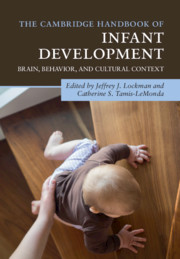Book contents
- The Cambridge Handbook of Infant Development
- The Cambridge Handbook of Infant Development
- Copyright page
- Dedication
- Contents
- Illustrations
- Contributors
- Preface
- Part I Foundations
- Part II Perceptual Development
- Part III Cognitive Development
- 12 Infant Memory
- 13 Infant Physical Knowledge
- 14 Infant Categorization
- 15 Early Knowledge About Space and Quantity
- 16 Infant Learning in the Digital Age
- Part IV Action
- Part V Language
- Part VI Emotional and Social Development
- Index
- References
13 - Infant Physical Knowledge
from Part III - Cognitive Development
Published online by Cambridge University Press: 26 September 2020
- The Cambridge Handbook of Infant Development
- The Cambridge Handbook of Infant Development
- Copyright page
- Dedication
- Contents
- Illustrations
- Contributors
- Preface
- Part I Foundations
- Part II Perceptual Development
- Part III Cognitive Development
- 12 Infant Memory
- 13 Infant Physical Knowledge
- 14 Infant Categorization
- 15 Early Knowledge About Space and Quantity
- 16 Infant Learning in the Digital Age
- Part IV Action
- Part V Language
- Part VI Emotional and Social Development
- Index
- References
Summary
Physical reasoning is the ability to go beyond the information in the immediate perceptual array. For example, if I were to dangle my keys in front of me with the intention of letting go of them, everyone would predict that the moment I let go of the keys, they will fall towards the ground. Similarly, if I hide my keys behind my back, everyone has the expectation that the keys continue to exist and that the shape and size of the keys remain the same as they were before they were hidden from view. These two examples demonstrate that people share the same basic ideas about how objects behave and interact. These expectations may be universal across all humans, and they may even be shared by some other species. However, researchers are still puzzled by some aspects of these fundamental abilities. For instance, even though most people can effortlessly draw similar predictions about these events, we have yet to build a computer that can rival the physical reasoning abilities of a typically developing 1-year-old infant. In this chapter, we argue that one way to resolve some of the mysteries about physical reasoning is to look at the origins of the abilities and how they change over time. We start by reviewing the literature on the physical reasoning abilities of human infants.
Keywords
- Type
- Chapter
- Information
- The Cambridge Handbook of Infant DevelopmentBrain, Behavior, and Cultural Context, pp. 363 - 380Publisher: Cambridge University PressPrint publication year: 2020



